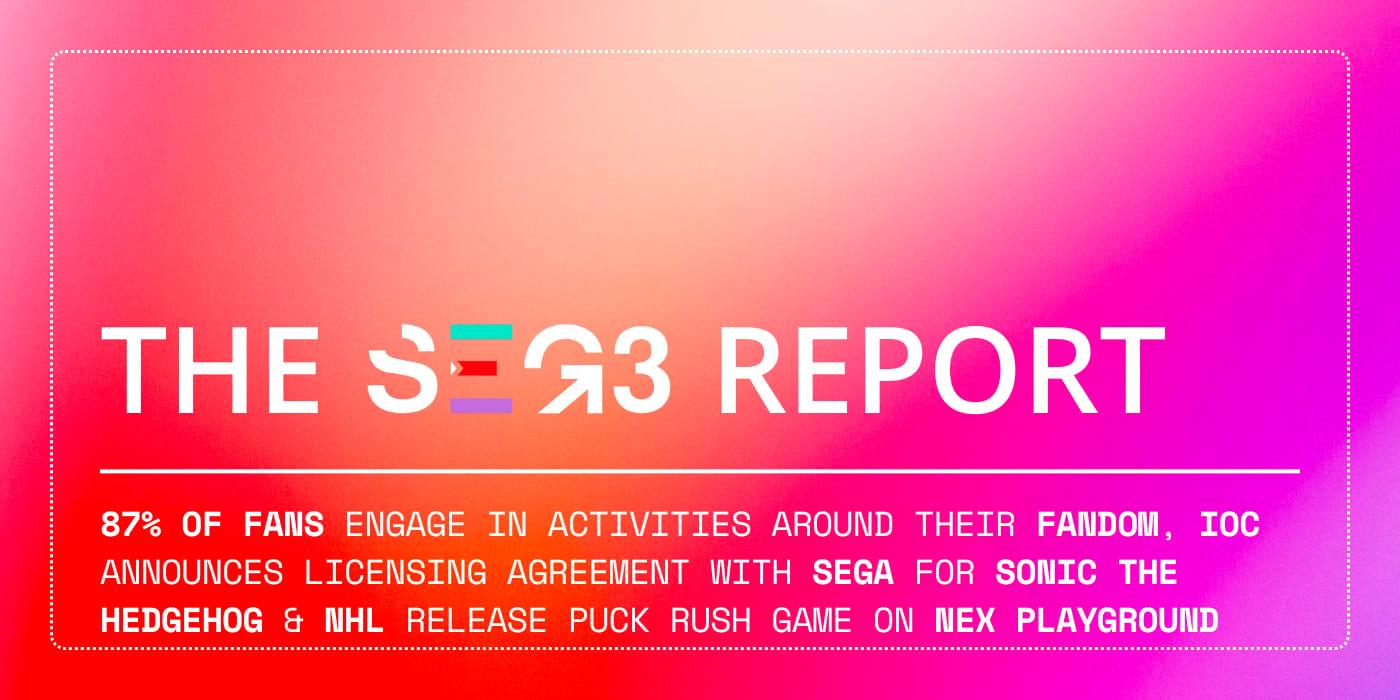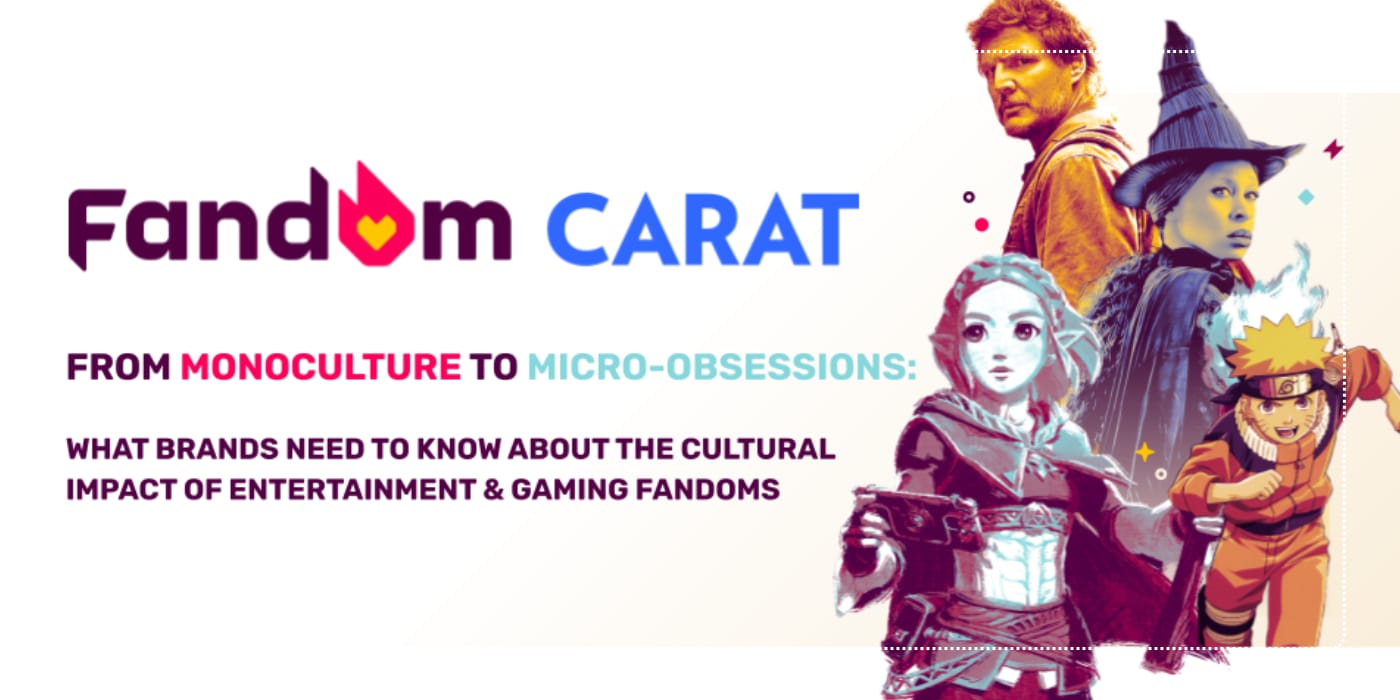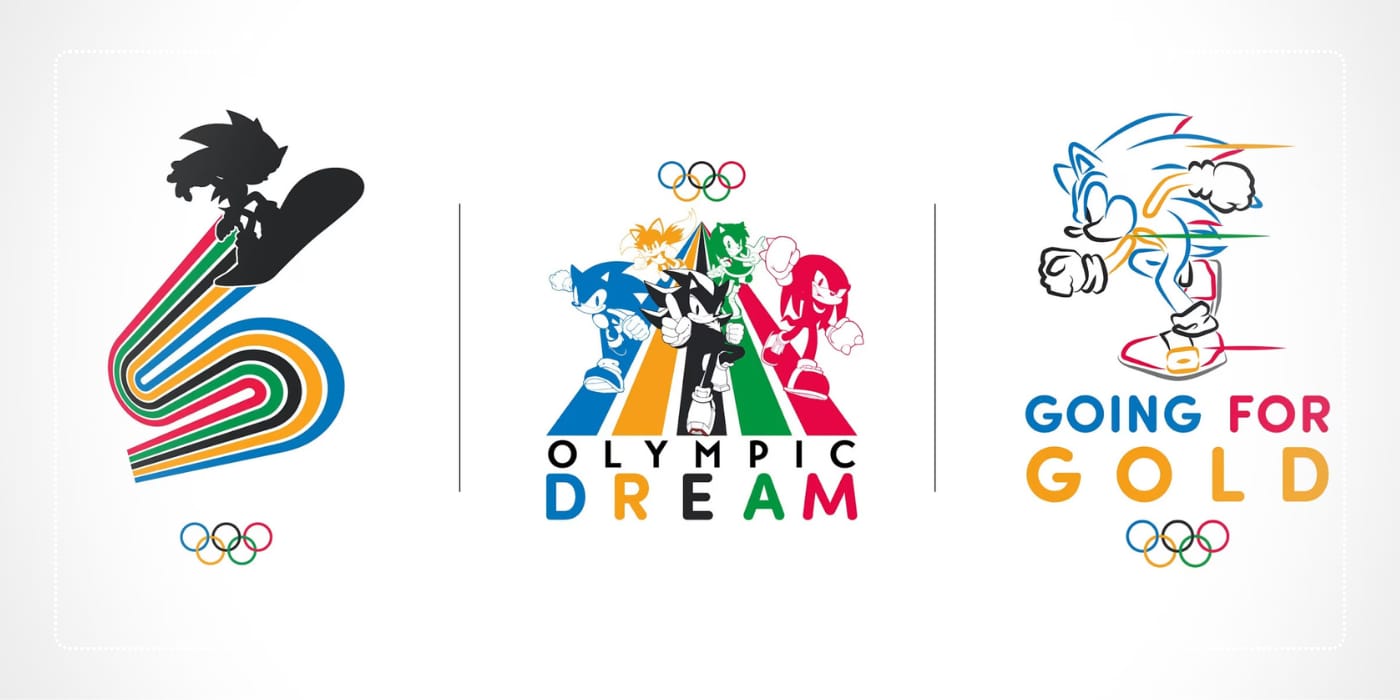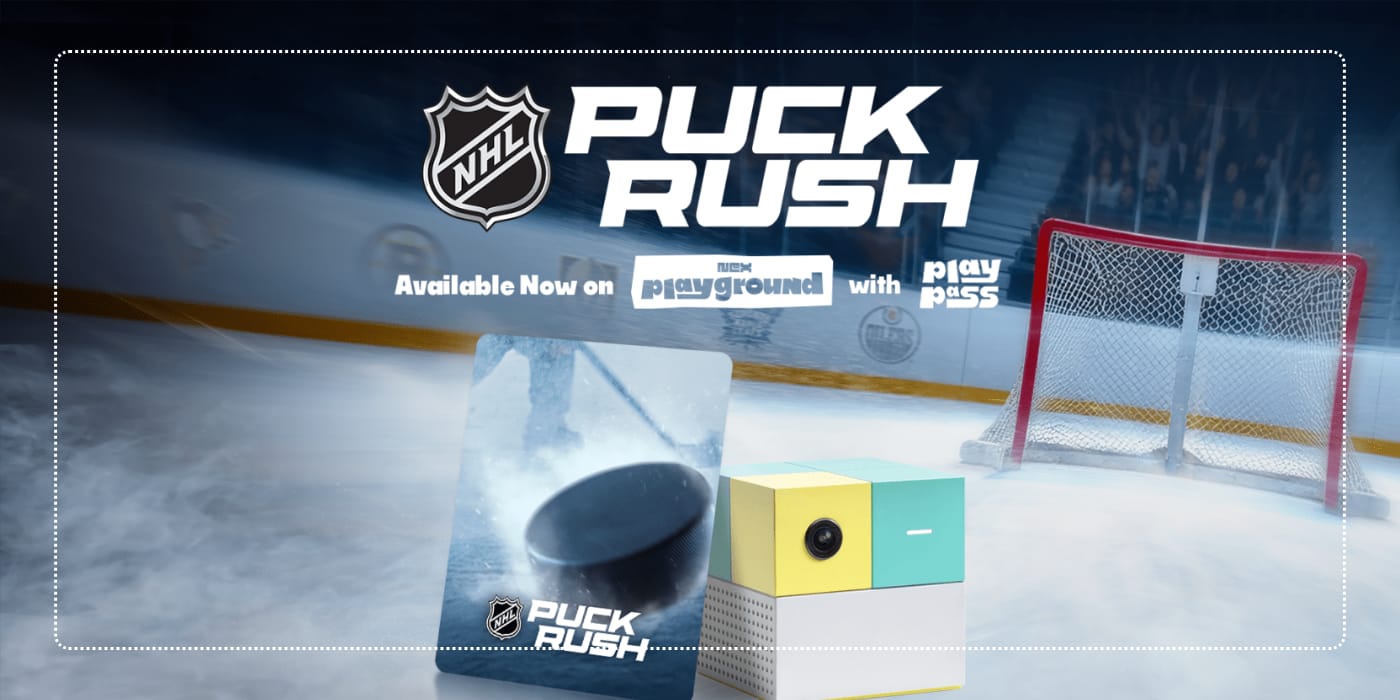- The SEG3 Report
- Posts
- 87% of fans celebrate their passions this way...
87% of fans celebrate their passions this way...
& International Olympic Committee announces long-term licensing agreement with SEGA for Sonic the Hedgehog + NHL releases Puck Rush game on motion-based console Nex Playground
Hey folks. Welcome to Edition #80 of The SEG3 Report!
Today’s spotlighted piece dives into Carat US & Fandom’s latest report, what you need to know about the cultural impact of entertainment & gaming fandoms, and how you can successfully activate your communities.
Also covered: IOC & SEGA announce long-term licensing agreement for Sonic the Hedgehog + the NHL’s partnership with motion-based console Nex Playground for Puck Rush game.
Let’s dive in:
Contents: Edition #80
87% of fans engage in activities around their fandom
Carat US and Fandom have published new research mapping how audiences engage with their fandoms, showing how fans interact across mass, mid-tier and micro moments, alongside how brands can build stronger connections with communities by leaning into cultural touchpoints and content creation.
TL;DR:
Fandom isn’t one-size-fits-all; different archetypes means different needs.
Success comes from creating the right moments (Mass, Mid-Tier, Micro).
There are 5 drivers to creating moments: worldbuilding, consistency, ratings, fanbase, cultural relevance.
87% engage in fandoms; 42% (50% Gen Z) create content around it.
75% say fan culture is as fun as the content itself.
Big or small budget; resonance matters more than scale.
Brands that support fans and their energy shape culture.
Fandom. It’s what makes our industries tick, and differentiates our properties from just being any old brand that consumers swap out for alternatives at the drop of a hat.
It’s this passion that we have for our favourite sports team, series or game that makes it become part of our identity, and that deep emotional connection that can bring a lifetime of loyalty if nurtured properly.
And so, in spotting this research from Carat US & Fandom (aptly named), and giving it a flick through, it highlighted some interesting findings for those looking to lean into their communities fandom.
So, what did it uncover?
Unsurprisingly, it shows that fans are not just one homogeneous blob. There are multiple archetypes of a fan, with each having very different expectations and needs. This means to service their fandom, you need to know what lever to pull, and when, to drive them to action.
The report categorises the type of fans into four ‘buckets’; these being those that want:
To dive deeper
To have connection
To celebrate
To create
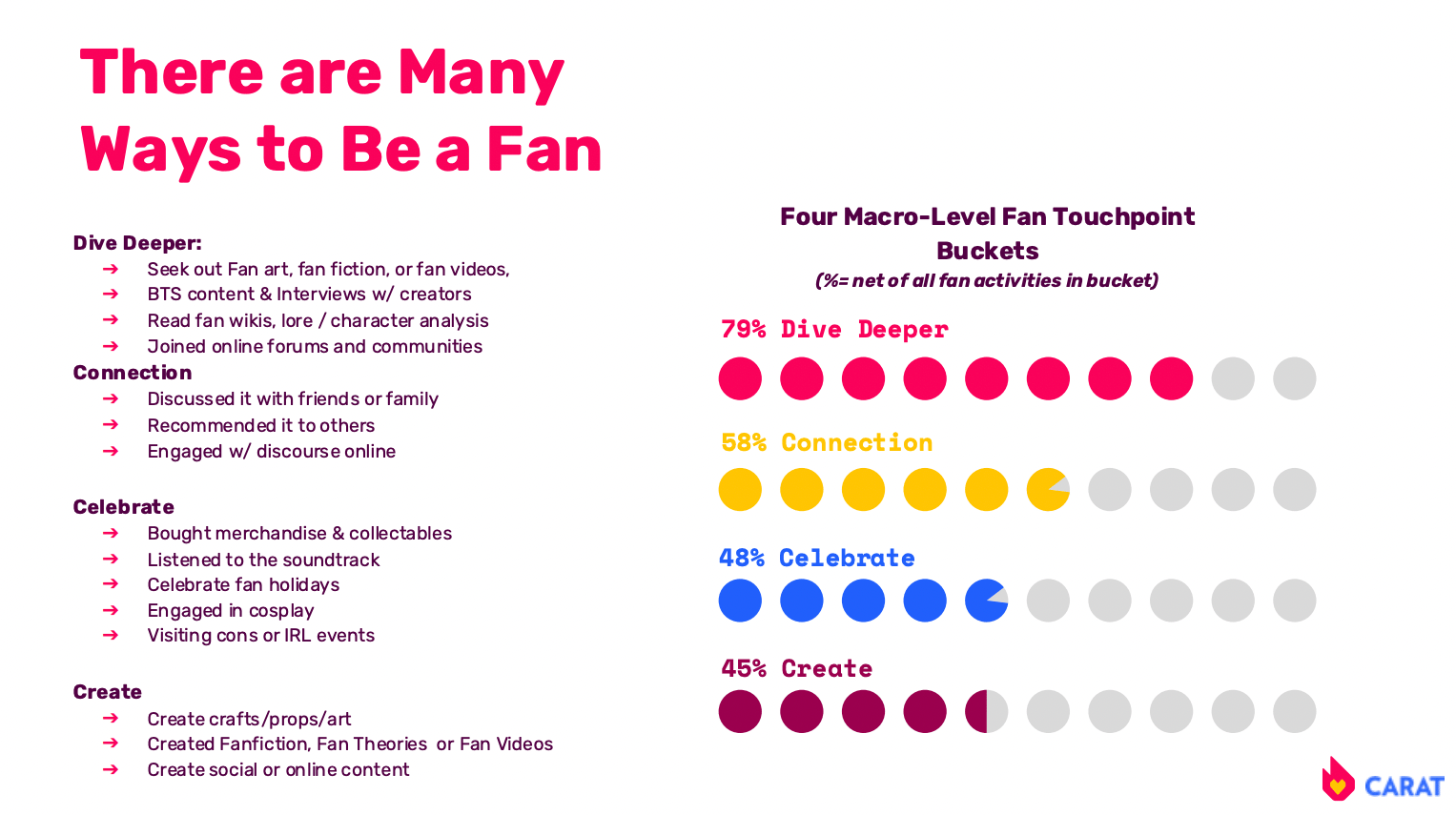
Understanding each ‘bucket’ and each fans motivation for engaging in those ways is the first step to creating moments (whether that be content or experiences) that resonate.
And per the report, there are three types of moment that can help shift culture, these being:
Mass Moments - these are created when a well-established franchise, with a global and loyal fanbase, drops something. They have the cultural credentials needed which mean they can draw audiences from all parts of fandom - i.e. the upcoming GTA release.
Mid-Tier Moments - designed for specific audiences - i.e. K-Pop Demon Hunters. Typically for a slightly less broad audience, but if you can put that content in front of an inquisitive, large audience (say, through a large streaming platform like Netflix), there’s the opportunity it can trend and be elevated to a mass moment.
Micro Moments - smaller budgets and designed for specific types of audiences i.e. horror films - but has an extremely strong audience that supports the niche extremely well.
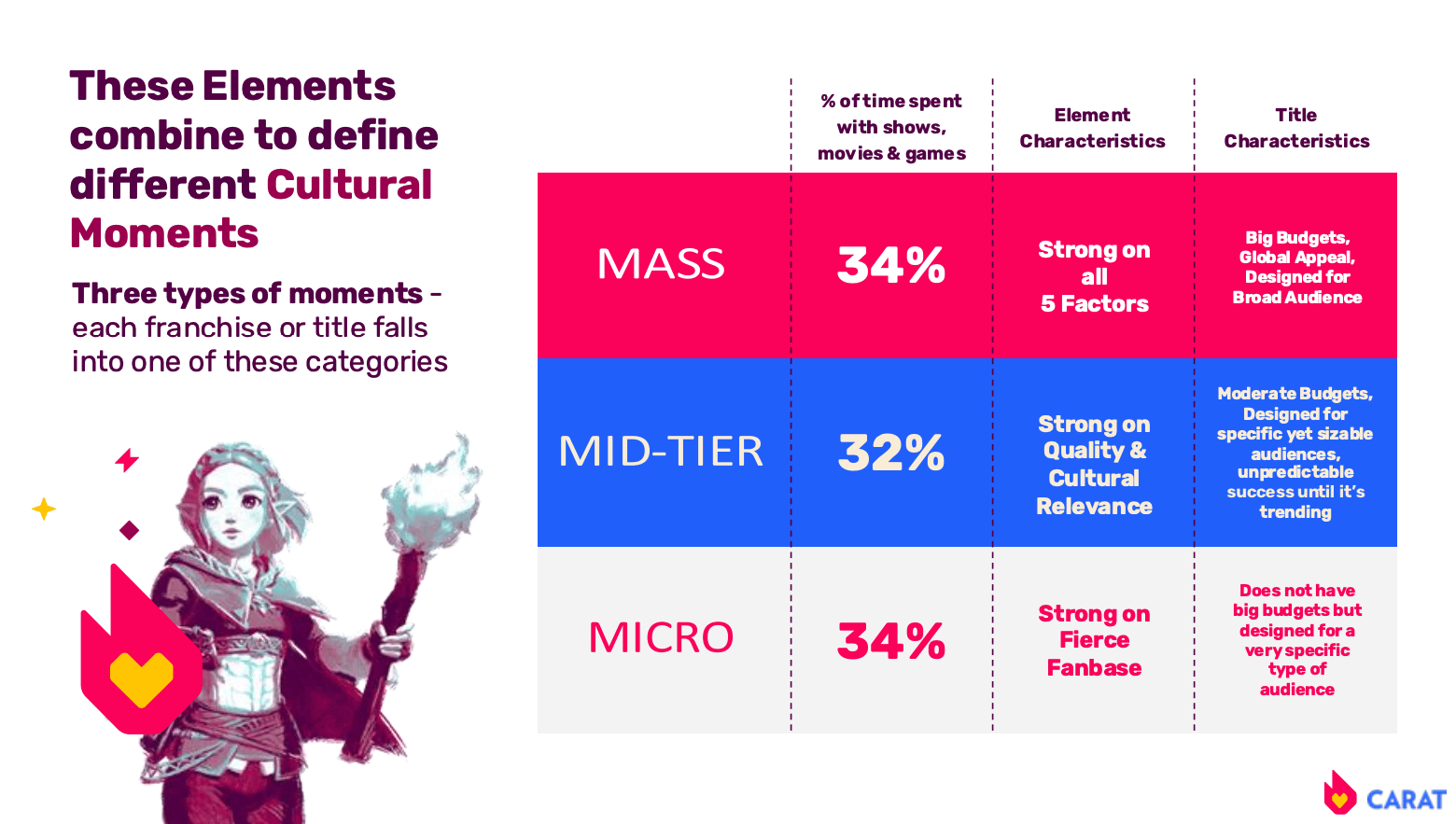
Per the report, which moment your release falls into relies on the combination of 5 factors, and how many of these factors you meet - these being:
Worldbuilding
Consistency
High Rating
Fierce Fanbase
Cultural Relevance.
If you combine all 5 elements, this will be a Mass Moment, and is responsible for 34% of time spent by fans.
Mid-Tier Moments, which are strong on cultural relevance & rate highly, are responsible for 32% of time spent by fans.
And lastly Micro Moments, which are more niche, but supported by fierce fanbases, are responsible for 34% of time spent by fans.
The overarching positive here for studios and emerging creators alike is that the time spent by fans is fairly even across all three category of moments - meaning no matter the budget you have, if you can design your content or experience to hit the key factors, you can find audience and fandom.
What are the other key findings, and how can these help you shape your strategy?
Finding 1 – More people are creating content about their fandoms
87% participate in activities surrounding their fandoms, with 42% creating content surrounding their fandoms. This number jumps to 50% when talking Gen Z.
Strategy tip: Fans want to immerse themselves in their fandoms, and UGC platforms are allowing fans to create content, or games, about your IP or franchise in lightning quick speed. Old frameworks would suggest that keeping everything in-house ensures quality control - but we’re now seeing creators paying pages/fans to clip up their content and share it so that it is everywhere.
Protection of your IP is important, but nothing can become a hit without visibility, which makes distribution vitally important for building and growing fandom.
Finding 2 – Fans are happiest when engaged in fan culture
75% of respondents said that engaging in fan culture was just as fun, if not funner, than actually engaging in the content itself.
Strategy tip: Now you have the visibility and distribution, you have people’s attention and interest. How can you then provide more opportunities for your fans to interact with other members of your fan community, and build connection based on your franchise, series or sport?
Being the reason and connection point for friendships, is a really powerful reason for fans to stay engaged with your franchise or brand.
And with 3 in 4 craving this as part of their fandom, you need to be finding a way to service that need, or you’re missing out on valuable opportunity to become an even more integral part of your fans lives.
Closing Thoughts
What the research reinforces is that fandom isn’t one-size fits all. Niche audiences can be just as powerful, and all fans crave content and experiences that allow them to immerse themselves further into your world.
And in my opinion, the franchises and brands that adapt traditional frameworks and design ecosystems centred around fandom, and their communities energy and intrigue, will be the ones that shape the next era of popular culture.
Your job? Give them something worth talking about, spending on and staking their identity on.
International Olympic Committee & SEGA announce multi-year licensing agreement for Sonic the Hedgehog
The International Olympic Committee (IOC) and SEGA have signed a multi-year licensing agreement featuring Sonic the Hedgehog. Launching from 2026, the partnership will span merchandise including apparel, toys, stationery and sports equipment, and forms part of the IOC’s wider Global Licensing Strategy to keep fans engaged with the Olympic brand between Games.
TL;DR:
SEGA x IOC partner again, with Sonic merch launching in 2026.
Previous gaming crossover (Mario & Sonic at the Olympic Games) sold 27M copies / $1.42B revenue.
Nostalgia + character/sport fit = natural crossover.
Big play to re-activate dormant fans and grow Sonic’s cultural relevance.
We have yet another SEGA partnership to tell you all about for Sonic the Hedgehog, and this time, it’s with arguably the world’s most recognisable sports brand - the International Olympic Committee (IOC).
SEGA have really upped the ante over the past 12-18 months, cementing Sonic’s place in mainstream culture, and with the Olympics license, the Winter Olympics in Cortina next year, and Summer Olympics in LA in 2028, this could become one of the most powerful partnerships to date if leveraged correctly.
Why should you care?
For the Gen Z’ers & Millenials amongst you, you will recall that this is not the first time that SEGA & the IOC have teamed up to bring Sonic to the Olympic Games.
Mario & Sonic at the Olympic (and Winter) Games reportedly sold over 27 million copies across all platforms, driving an estimated $1.42 billion in gross revenue.
Numbers worthy of a gold medal.
So, what’s the plan for the new collab?
Merchandise.
Which to again paraphrase a statement that has stuck with me from Justin Scarpone, EVP Global Head of Transmedia from SEGA, ‘merch is a great way to tell stories’.
And so it’s no surprise that a full range of licensed merchandise, including apparel, toys, stationery and sports equipment, planned for release in 2026.
Details haven’t been released as of yet, but my guess would be that…
Nostalgia will play a part
In Edition #41, we covered The Sonic franchise in more depth, and the six stages of a fans lifecycle. I may be biased here given I personally loved the crossover - but given the success of the previous collaboration, there is almost certainly a dormant audience that has a connection to both Sonic and the Olympics, and can be re-acquired/activated once again through this collab.
Whether retro or current, there’s so much scope for the crossover because of…
The IP, Character & Story match
In my view, this is a collaboration that makes itself, with so many Olympic sports lending themselves to attributes of Sonic characters.
I already can’t stop thinking about Knuckles with Boxing, Tails with Pole Vault and of course Sonic in Athletics and the rings. There are so many ways to activate the partnership, and to create merchandise that honours the sports that make up the Olympics, whilst leaning into the personalities, attributes and characters that make up the Sonic franchise.
Closing Thoughts
The DNA of the Olympics and Sonic is a natural fit, and SEGA is showing how nostalgia, character alignment and the right license can inject new energy in a long-standing franchise.
And the part you should all be taking away from this collab? Find where your IP naturally crosses over with the things people already love.
If you can find that sweet spot, no matter the medium (whether that be games, merchandise etc), you can drive relevance, re-acquire dormant fans and build long-term cultural value.
(Plug: don’t forget you can hear from SEGA’s Chief Brand Officer at SEG3 LA this December).
NHL releases Puck Rush on Nex Playground; becomes first sports league title on system
The NHL has partnered with Nex Playground to debut NHL Puck Rush, the league’s first motion-based console game. Designed for families and younger players, the title lets fans score goals, unlock team gear and play in short bursts of timed action, with launch activations taking place at the NHL Shop in New York City.
TL;DR:
There are no ads, no online interaction or microtransactions on Nex Playground
The game is motion-based, which I’m sure parents trying to get their kids active will love.
Gaming is huge. Try new platforms, not just the big ones.
Design games and format to match how families actually play (short + competitive).
Use digital launches as an excuse to drive fans to IRL experiences.
The NHL are going all phygital on us, with a game, Puck Rush, launched on Nex Playground - a motion-based console that requires no internet connectivity, and has no online interactions, no ads or opportunities to make in-game purchases.
A very different model to many in the market - but it seems to be paying dividends, with games live on the console from the likes of Sesame Workshop, Mattel, NBCUniversal, Hasbro, DreamWorks and more.
Why should you care?
There is often pushback around gaming as a whole that it is to blame for the lack of physical activity in youth audiences (a lazy argument IMO).
But for sports leagues like the NHL, where their core product revolves around peak performance in Ice Hockey, Nex Playground likely offers that happy median for parents between gaming and physical activity.
And for the NHL, who are battling for the attention of youth audiences, exploring new platforms like Nex Playground can help them to tackle some of their challenges, which Charles Campisi, Director of Innovation & Growth Strategy at the NHL, spoke to at SEG3 LA 👇
So, what’s there to steal from this move by the NHL?
1 - Map out your product strategy, and explore new territory
Gaming is enormous, and contains many different types of audience, platforms, titles, consoles and more.
Whilst UGC gaming is what’s hot, exploring emerging consoles like Nex Playground offers new opportunities to engage with a younger audience in a way that most parents will support.
2 - Format is important
The game, Puck Rush, is built for short, timed bursts of play, which mirrors how younger audiences and families often consume games today. Siblings and families that love sports are inherently competitive - quick fire shooting games lean into that rivalry nicely.
3 - It’s combined with IRL experiences in-store
And as we spoke about above, fans want spaces to engage with others that are part of their community.
By launching at the NHL Shop in New York, the league is turning the game release into a physical activation too.
It’s a reminder that games (or any digital product for that matter) can be springboards for IRL engagement, and an excuse to bring fans closer to the brand.
Closing Thoughts
Sports brands have always dreamed of bringing the real action into the living room, and given Nex playground doesn’t require a controller, it gets fans moving in ways that feel closer to the real thing.
I’d bet this appeals to more of the organisation than just marketing, and into community and health-focused initiatives - but the real question is whether fans buy in too!
In other news this week:
Amazon introduces new interactive features for Prime Sports alongside the NBA: read here.
BOSS, Apple & Aston Martin F1 launch immersive storytelling experience: see here.
Dallas Cowboys integrate into Secret Red vs Blue Fortnite island: read here.
Ubisoft partners with VISA & Boursorama for Trackmania: read here.
AWS becomes Official Cloud and Cloud AI Partner of the NBA & WNBA: read here.
Supercell launch AI Game Hack-athon: read here.
NBCUniversal brings in 170 partners for linear and digital broadcasts of NBA: read here.
Walt Disney Imagineering to trial Meta Ray-Bans as virtual assistant for customers at Disneyland: read here.
ITV extend broadcast deal with Formula E until 2027: read here.
Sports Interactive partner with Gadsme in three-year deal for in-game advertising of Football Manager: read here.
Rival acquires social gaming platform Shake: read here.
Discord launches new ad formats, and partners with AppsFlyer & Gamesight for ads measurement: read here.
Layer-2 Blockchain Arbitrum launches Arbitrum Gaming Ventures: read here.
Creative Artists Agency launch CAA Creators: read here.
G2 partner with Lufthansa for League of Legends worlds: read here.
FOX Sports to stream NFL thanksgiving game on Tubi: read here.
Working on anything cool, or have a press release you would like us to cover? Send it in for the chance for it to be covered in next week’s edition!
What'd you think of the SEG3 Report? |
That’s all for now everyone - thanks again for reading the latest edition of The SEG3 Report, and if you found it of interest, please do consider sharing with a colleague or friend!
